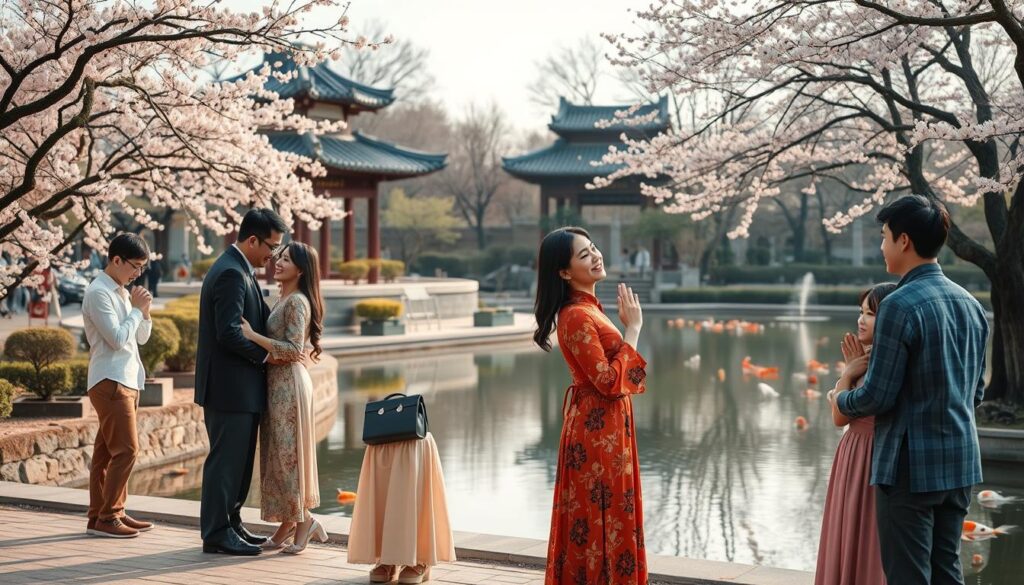Asian sexual relationships are deeply influenced by cultural factors and ethnic diversity. These unique dynamics shape intimate connections across Asian communities. Sexual behaviors vary widely among different Asian populations, reflecting complex social norms.
Asian American students often have more conservative sexual attitudes. Research shows Asian undergraduates have lower frequencies of intimate interactions. This approach stems from deep-rooted cultural values and communication strategies1.
Intercultural communication is key to understanding these relationship dynamics. Asian immigrants, especially long-term residents, show changing views on sexual attitudes. They become more open to diverse cultural experiences1.
Understanding these relationship patterns can help bridge cultural gaps. It also promotes mutual respect among different communities.
Key Takeaways
- Asian sexual relationships are shaped by complex cultural influences
- Conservative sexual attitudes are prevalent among Asian populations
- Intercultural communication significantly impacts relationship dynamics
- Sexual experiences vary across different Asian ethnic groups
- Long-term immigrants tend to develop more flexible relationship perspectives
Understanding Asian Preferences in Relationships
Asian relationship dynamics blend cultural influences, societal norms, and personal choices. Studies show that preferences in Asian cultures mix traditional values with modern perspectives2.
The Cultural Framework of Relationship Choices
Cultural context plays a key role in Asian relationship dynamics. Family expectations and traditional values shape romantic relationships in many Asian societies2.
Research shows that young Asian adults often have conservative views on dating and marriage2.
- Parental approval remains a critical factor in relationship decisions
- Filial piety profoundly influences romantic interactions
- Cultural background determines relationship expectations
Family Values and Relationship Dynamics
Family greatly impacts relationship preferences in Asian cultures. In 2020, attitudes toward relationships began to shift in some Asian countries.
In China, 64.6% of college students accepted premarital sexual relationships2. Marriage ages have also changed in countries like South Korea and Japan.
Men now marry around 31, while women marry at 292.
Cultural expectations continue to evolve, blending traditional values with contemporary perspectives.
Gender Roles and Romantic Expectations
Relationship preferences vary across different Asian communities. Personal experiences and cultural background shape dating choices. Research shows that young adults prioritize different aspects of relationships3.
Some groups maintain traditional views, while others embrace more progressive attitudes. Asian relationship landscapes are diverse and always changing.
Common Practices in Asian Sexual Relationships
Asian sexual relationships are shaped by complex cultural dynamics. Identity formation greatly influences intimate connections across diverse Asian populations. These relationships differ from Western approaches due to unique cultural nuances.
Cross-cultural understanding is key when exploring Asian relationship patterns. It helps uncover the intricate details that make these connections special.
Dating Rituals and Traditions
Asian dating practices often reflect societal norms that value family expectations. These norms prioritize collective harmony over individual desires. Many Asian cultures emphasize long-term commitment in relationships.
Romantic relationships in Asian communities typically progress at a slower pace. This allows partners to build a strong foundation for their future together.
- Respect for familial preferences in partner selection
- Emphasis on long-term commitment
- Slower progression of romantic relationships
Demographic studies reveal interesting facts about Asian romantic interactions. Asian American men face challenges in partnerships. Only 35.8% are married or cohabiting compared to 59.1% of Asian women4.
Importance of Communication and Consent
Asian relationship communication often differs from Western models. Many Asian cultures prefer indirect communication and contextual understanding5. Consent discussions can be subtle and influenced by social structures.
Cultural sensitivity transforms relationship dynamics.
The Shift Towards Modern Perspectives
Asian communities are experiencing changes in relationship dynamics. Out-marriage rates show increasing openness. 36% of Asian women marry outside their racial group6.
Young Asians are challenging traditional relationship frameworks. They embrace individual approaches while maintaining core cultural values4.
National Longitudinal Study of Adolescent to Adult Health5Asian Sexual Relationship Research6Demographic Marriage Trends Study
Challenges and Opportunities in Asian Relationship Dynamics
Cultural interactions shape modern dating experiences. Intercultural communication reveals unique challenges in identity formation. Globalization has transformed perceptions of attractiveness and partnership7.
Stereotypes have long impacted romantic relationships. Recent cultural shifts challenge outdated narratives about Asian men’s desirability. K-pop and Asian media offer nuanced representations of Asian masculinity7.
Dating behavior now reflects a more inclusive approach. Younger generations are open to diverse partnerships beyond cultural boundaries. Embracing these changes can lead to meaningful connections7.
An in-depth exploration of relationship dynamics shows the importance of breaking stereotypes. Healthy relationships need empathy and understanding. Challenging existing norms is key to personal growth7.
Recognizing diversity within Asian communities is crucial. Approach relationships with an open mind. Socio-economic factors and cultural views still shape romantic interactions7.
FAQ
What unique challenges do Asian Americans face in romantic relationships?
How does acculturation influence sexual behaviors among Asian Americans?
What are the communication challenges in Asian relationship dynamics?
How do cultural norms impact sexual experiences for Asian Americans?
What role do gender expectations play in Asian relationship dynamics?
How are digital spaces impacting Asian American youth relationships?
What support exists for diverse Asian communities in relationships?
Source Links
- Ethnic, Gender, and Acculturation Influences on Sexual Behaviors – https://pmc.ncbi.nlm.nih.gov/articles/PMC4423398/
- Romantic Relationships and Attitudes in Asian Emerging Adults: Review and Critique – https://fincham.info/papers/2024-asianrel.pdf
- Exploring Dating Preferences and Perceptions of East Asian Men: Insights from a Recent Survey — 紅娘 – https://www.awmlove.com/blog/exploring-dating-preferences-and-perceptions-of-east-asian-men-insights-from-a-recent-survey
- Relationship Involvement Among Young Adults: Are Asian American Men an Exceptional Case? – https://pmc.ncbi.nlm.nih.gov/articles/PMC4631383/
- About Last Night: Asian attitudes differ towards sex – https://www.smh.com.au/lifestyle/life-and-relationships/about-last-night-asian-attitudes-differ-towards-sex-20200409-p54iqh.html
- The Three Body Problem in Asian American Romance – https://going2peace.medium.com/the-three-body-problem-in-asian-american-romance-703d0968a53c
- Asian Men vs. Caucasian Men: Exploring Dating Dynamics — 紅娘 – https://www.awmlove.com/blog/asian-men-vs-caucasian-men-exploring-dating-dynamics
